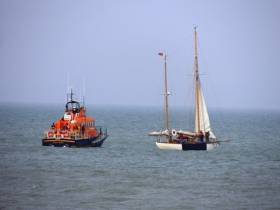Displaying items by tag: Maybrid
When the report appeared here on Afloat.ie on Monday about the assistance given by Arklow RNLI to the “stranded” classic yacht off the Arklow pierheads on May 1st, warning bells rang writes W M Nixon.
For classic boat enthusiasts will have instantly recognised that the yacht in question is the 43ft ketch Maybird, built by Tyrrells of Arklow in 1937, and superbly restored in the heart of the classic yacht industry in Southampton between 2009 and 2011 by a team of all the talents in a job project-managed by owner Darryl Hughes.
Most folk on the classic yacht circuit will be aware that Maybird is entered for the Volvo Round Ireland Race from Wicklow on June 18th, in which she’ll be the oldest boat ever to have taken part. And those of us really in the know will have been aware that Darryl Hughes hopes that members of Arklow Sailing Club - and maybe even descendants of the men who built the boat back in 1937 – will be on the crew for the big race.
The Arklow maritime community being what it is, many members of the sailing club are also on the RNLI Lifeboat Crew panel, and thus some of them were on board Maybird when she set off from Cork Harbour to sail for Arklow early last Saturday as part of a programme to build up mileage experience in order to qualify for the round Ireland.
So when the photo appeared on Monday showing Maybird about to be taken in tow on Sunday evening by the Arklow lifeboat after her engine had failed right in the entrance to Arklow Harbour, at first all we could think of was the embarrassment of those on Maybird at having to be “rescued” by their colleagues.
But then we remembered that May 1st, May Day, is a great lifeboat fund-raising day, and particularly so in Arklow. So then cynical thoughts took over, thinking that maybe this was a cleverly-planned fund-raising stunt: Maybird, Mayday, May*rs* we thought.
There are times you can be just too hard-bitten. Turns out the whole story is absolutely kosher. Prior to leaving winter quarters in Crosshaven, when servicing the engine Darryl had noticed the bleed screw on the secondary fuel filter did not seem to be making an airtight fit. But the engine started with no bother, and motored the boat without trouble from Crosshaven to the Custom House Quay in Cork to meet the Arklow crew, and then took Maybird, with full complement aboard, down to Cobh on Friday evening to prepare for departure towards Arklow last Saturday morning.
They’d a fine sail round to the east coast, going outside the Tuskar to simulate round Ireland conditions, but then off the Glassgorman Bank an engine start test failed. There was air in the fuel system, but Darryl solved the problem with plumbers’ PTFE tape on the bleed screw, and they were back in business with a fading breeze, motoring the final miles and stowing sails with the engine performing well.
But just as the pierheads came abeam, the engine cut out. Fortunately Maybird’s multiple-sail rig provides almost instant hoisting of the staysail – “always the last sail to be stowed” – and they were able to sail clear and keep the situation under control while the Arklow lifeboat leapt at the chance to carry out a rescue.
As it happens, Jimmy Mylor, who organises the Arklow Sea Scouts in addition to being on the Lifeboat Crew, had meant to be on Maybird, but work commitments had caused him to drop out. Yet it was he who handed Maybird’s crew the lifeboat’s towing warp amidst much banter, banter which went on for some time.
But now the Arklow marine industry have rallied round to make sure that a new bleed screw on Maybird’s secondary filter is getting a proper seal, and all being well, Maybird will race this Saturday in Arklow SC’s weekend event. We don’t know how much extra RNLI fund-raising was done as a result of this “stunt-for-real”. But the message yet again is that you can only have three problems with a good modern marine diesel engine – fuel, fuel, and fuel.

Maybird as she looks when all is as it should be
























































